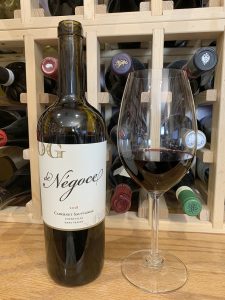Deep ruby color; black cherry, blackcurrant, graphite, lavender on the nose; black cherry, blackcurrant, blackberry, plum, mocha, oak, spice on the palate.

Dry; silky but significant tannins. The maker advises a 24-hour decant, which may be overkill, but decanting clearly is called for both to smooth this out and because there is significant sediment. After my Wine Breather by Menu first stage of decanting, which does not help in avoiding sediment, I poured from the decanter through a metal screen. Medium-plus body. Finished in 100% new French oak, but length of time not revealed. 14.9% ABV
Rich, dark fruit flavors dominate. This is the muscular, assertive style of Napa cab. The fruit comes from Sleeping Lady Vineyards, which explains the powerful tannins, structure, and complexity. Sleeping Lady Vineyards produce some of the best fruit in Napa and most wines made from its grapes is sold by allocation and not available to the general public.
That is the case with this wine. As the name implies, de Négoce is a négociant operation. In this case, it means de Négoce (French for “of trade”) makes no wine but puts their label on a bottle and sells it. It was somewhat of a surprise that de Négoce revealed the grape source, but other facts are withheld because this operation gets juice or wine from high-end wineries, my guess is wine/juice left over after the winery achieves its bottling goal. The Sterling Vineyard Sleeping Lady Vineyard Yountville Cabernet Sauvignon, one of the makers using the Sleeping Lady grapes, sells its product for $165. Wines from this vineyard consistently score in the 95-98 points range among wine critics.
Thus, when de Négoce claims this wine sells for $150 from its maker, I think that is reasonable. Using de Négoce’s system, it will cost you $35. I would not pay $150 for this, but it is a value buy at $35. Reviewing such wines is not something I typically do, but this system and these wines have been worth exploring and telling you about. This is the second de Négoce wine I have tried, and both have been excellent. Here is how the de Négoce system works:

• Cameron Hughes, a veteran négociant, only sells directly to the consumer through his Phoenix Wine Company.
• You join his “Wine Futures List” to be notified of new releases of special wines Hughes finds.
• Instead of bottling and cellaring wines, Hughes sells the wine, then bottles it and ships it.
• You cellar the wine for everal months—I have done so with the selections he sent me—to allow the bottle to recover from “bottle shock” and come around to present its best self. This is a task typically done by the winery. In this system, it is done by you.
There are cautionary details to keep in mind:
• You are required to buy in six or 12 bottle lots.
• You are, in most cases, buying wine and then waiting for delivery. Hughes buys some wines in barrel and then bottles. He acquires others that are offered as they come off the bottling line. Barreled wines take 6-12 weeks to ship. Bottled wines usually take 3-6 weeks to ship. He ships only when weather permits, so expect a hold in summer
• Since all the wines are recently bottled, they need time to rest after you get them. Bold, tannic cabs need 3-8 months. Medium bodied reds like pinot noir and zinfandel, 2-3 months. Medium-to-full bodied whites need at least two months and add complexity and bouquet when you wait six months. Light-body whites can be ready in 6-8 weeks, but they, too, benefit with more patience.
• The source wine usually is anonymous, so information about the wine is limited.
Here is how the company presents its case: “Ready for a secret? Wine does not cost a lot to make, it costs a lot to sell. Since the end of Prohibition, layer-upon-layer of government-mandated middlemen and cumbersome state-by-state distribution policies have created the world’s most inefficient wine market. Only in the USA does a wine that costs $10 to produce end up costing you $50.
“Enter de Négoce. With 20+ years of global wine sourcing experience, we have become the #1 direct-to-consumer wine brand in the country in just one year of business. How? We source excess exceptional wine from icon and boutique wineries and sell it directly to you at incredible prices. Simple. Here is our promise: buy direct from de Négoce, cut out the middlemen, and you will save 60-80% off traditional retail prices. We guarantee every wine we sell so you can buy with confidence.”
This system is not for everybody. You will get high quality wines, but you have to take on several of the responsibilities of the winery and the middlemen. The concept, however, is intriguing for the right person. Wine Enthusiast Magazine wrote: “It is one of the great mysteries of the universe how négociant Cameron Hughes produces wines like this at such a great price.”
